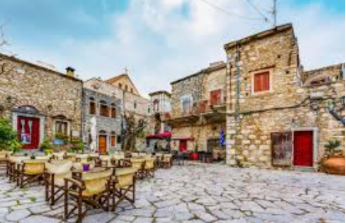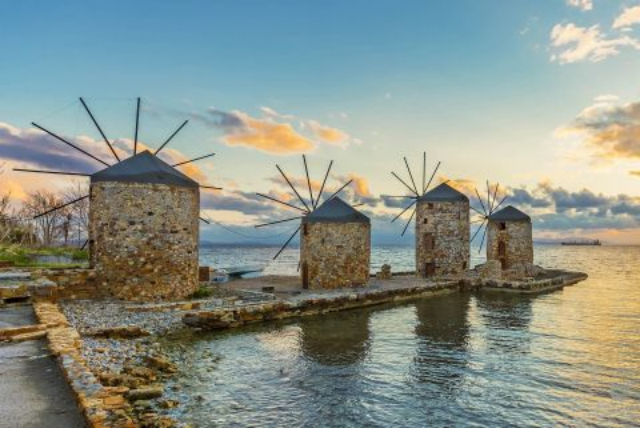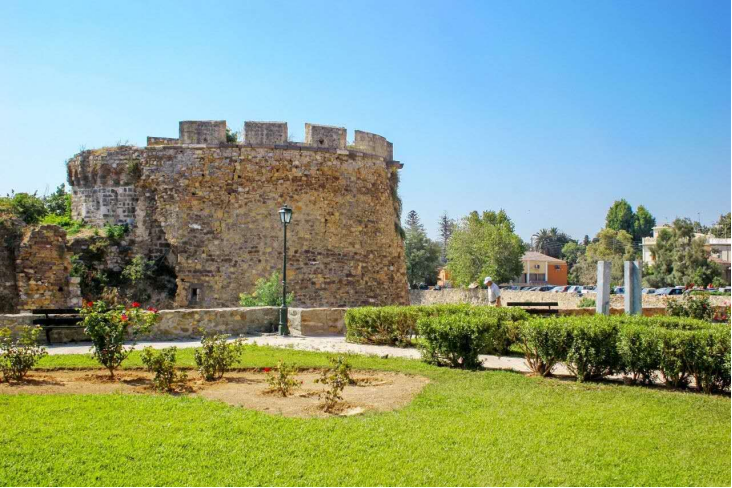Chios, Chios, North Aegean 作者: 来源: 发布时间:2021-05-18
I. Population, Area
Total Area: 842.3km2
Elevation: 1,297m (4,255 ft)
Municipal unit density: 62/km2 (160/sq mi)
Population: 51, 930 (2011)

II. Geography
There are daily flights from Athens and almost daily flights from Thessaloniki. Basically, you can reach Chios from anywhere in the world via Athens International Airport or Thessaloniki. There are ferries connecting Chios to Athens (Piraeus & Lavrio), Kavala, Lesvos, Limnos, Agios Efstratios, Samos, Ikaria and Tsesme (in Turkey). In the summer, connections to Paros or Naxos might be added. There are also ferries to the other islands of the Regional Unit of Chios, Oinousses and Psara.
III. ECONOMY
The local merchant shipping community transports several locally grown products including mastic, olives, figs, wine, mandarins, and cherries.
IV. Industrial Characterisitics
Sporadically for some time at early 19th century to 1950s there was mining activity on the island at Keramos Antimony Mines.
V.Attractions

There are four traditional windmills in Chios, 1.5 km north of Chios Town on the road to Vrontados.

The Medieval Castle of Chios, Greece: Initially, The Castle or Fortress of Chios enclosed the entire town of Chios. Later, the town expanded beyond the Castle walls. It was during the Byzantine period at the end of the 10th century that the first architectural phase of the monument was built. The original building has been renovated and almost nothing has survived from the initial construction. The Venetians reconstructed the Central Gate (Porta Maggiore) in 1694. You enter the Castle through this gate, located at the south end.
Ioustiniani Palace, a two-storey building stands in the enclosed area, near the gate. Kria Vrisi (Cold Fountain), the semi-subterranean water cistern built under the Genoese, and the massive tower known as Kulas are worth seeing.
In olden times, a wide moat surrounded the Castle. The Genoese, Venetians, and Turks, from the early 14th century until the Greek War of Independence, made a series of additions, renovations, and repairs. The main entrance of the Castle was consolidated, the facade of the building called Dark Dungeon was cleared, the roof was strengthened, the masonry was repaired, while the pavement is revealed after the passageway on the walls over the main gate was cleared. In present times, residents inhabit the Castle.
VI. History
According to ancient Greek mythology, the first King of Chios was Oinopeonas (or Inopion), grandson of Minos King of Crete, and son of Dionysus and Ariadne, who taught the islanders how to cultivate vines. The myth says that the island owes its name to the daughter of Oinopeonas, Chiona. Also according to the legend, Chios is said to be the birthplace of the famous lyric poet Homer. In fact, there is a rock in Vrontados village, called Daskalopetra, where Homer taught his poetry.
The first traces of inhabitants in the history of Chios date back to the Neolithic and Bronze Ages. During the 7th century BC, Chios, like Samos, excelled in arts and some of the best Greek sculptors of the time came from the School of Sculpture in Chios. During the naval Battle of Salamina, Chios joined the Persians. But during the Peloponnesian war, its inhabitants fought at the side of the Athenians and were under the control of Athens until 356 BC. After that, the island became independent and was not forced to pay the annual tribute to Athens anymore, which made it become prosperous. Chios then became part of the Roman Empire.
A notable person from the island was Erasistratus of Cheos (310 BC- 250 BC). He was a physician and studied the functions of the human heart in a purely scientific way, through performing dissections on criminals. He founded a medical school in Alexandria of Egypt and is believed to be the first to measure heart palpitations.
Byzantine period
At that period, emperor Constantine settled on the island. The Byzantine times followed these years, during which very few information has been saved. After the fall of Byzantium, Chios was under constant attack of Catalan and Turkish pirates. In the 14th century, the Genoese took the island and remained there until 1566, when Chios was recaptured by the Turks. Nevertheless, since the island was exporting mastic in many countries and selling it to the Sultan, its inhabitants had more privileges than in any other part of Greece.
Thanks to the trading, the island of Chios prospered in arts and letters. The School of Chios was founded in the 18th century and many churches and wealthy mansions were built. The population grew and the island had the privilege to be under the rule of the elder islanders of the community.
Massacre of Chios
With the Greek revolution of 1821, the inhabitants of Chios were roused by Lykourgos Logothetis of Samos who led his army to fight a Turkish garrison. When the Sultan heard what happened, he sent his fleet in Chios to punish the inhabitants for participating in the revolution.
On the 30th of March 1822, 7000 Turk soldiers under the command of Kara Ali Pasha disembarked on Chios and slaughtered 25000 of its inhabitants and forced almost twice that number of people into slavery. On the night of June 6th, 1822, Konstantinos Kanaris revenged for Chios massacre, by killing the Turkish Admiral Kara Ali Pasha. The massacre of Chios increased the sympathy of the rest of Europe and the growth of Philhellenism.
After the massacre, Victor Hugo wrote the wonderful poem Enfant de Chios and Delacroix painted Le Massacre de Chios, which can be admired in the Louvre Museum. The first refugees started to return to Chios in 1832. On the 22nd of March 1881, a disastrous earthquake destroyed the island, causing 6000 deaths, numerous damages and the destruction of many building in the capital. On the 11th of November 1912, the island of Chios was finally liberated and reunited with the newly built Greek State.
VII. Other Information
Chios is notable for its exports of mastic gum and its nickname is "the Mastic Island". Tourist attractions include its medieval villages and the 11th-century monastery of Nea Moni, a UNESCO World Heritage Site.
VIII.Contact Information
Mayor: Fulnos
Tel:0030 2270 44415
E-mail: mayor@chios. gr
Website:http://www.chios.gr/
